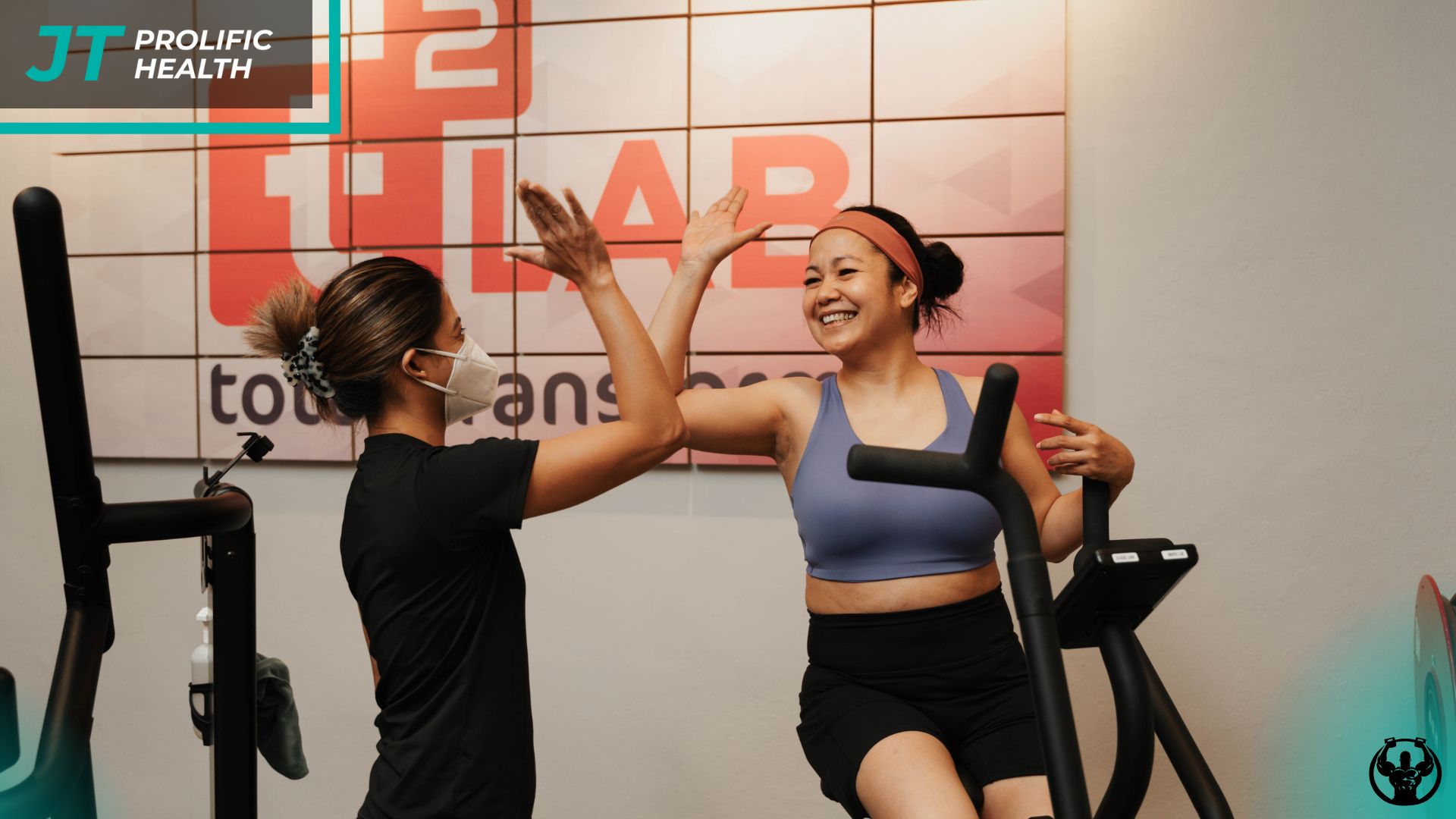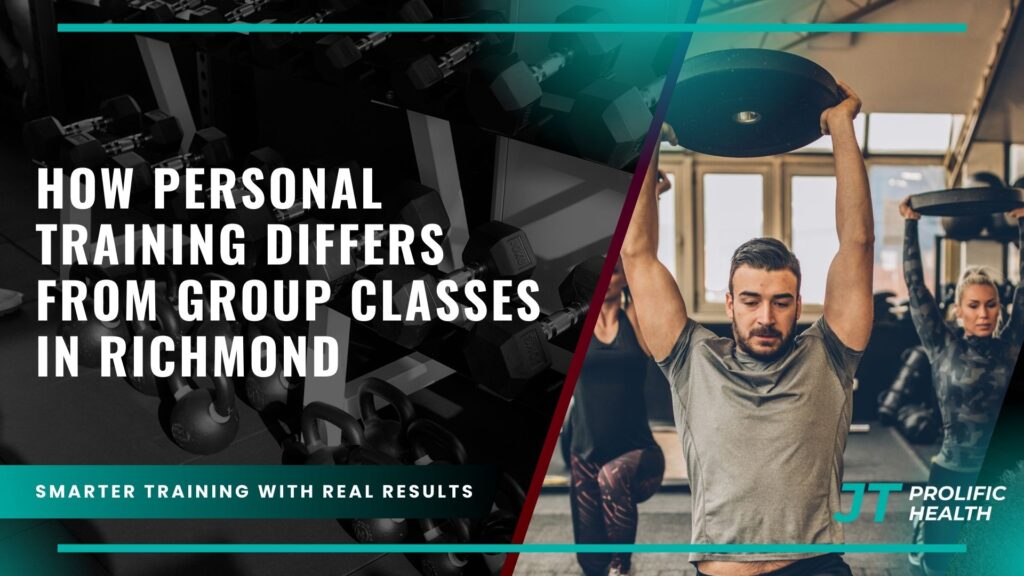When it comes to achieving your fitness goals in Richmond, BC, you’re faced with an important decision: should you invest in personal training or join group fitness classes? This choice can significantly impact your fitness journey, affecting everything from the speed of your progress to your overall satisfaction with your workout routine. Understanding the fundamental differences between these two approaches is crucial for making an informed decision that aligns with your specific needs, goals, and lifestyle.
Personal training and group classes represent two distinct philosophies in fitness instruction. Personal training offers a completely individualized approach where every aspect of your workout is tailored specifically to your body, goals, and limitations. In contrast, group classes provide a structured, community-based environment where participants follow the same general program while benefiting from shared motivation and energy.
The fitness landscape in Richmond has evolved significantly over the past decade, with both personal training studios and group fitness facilities expanding their offerings to meet diverse client needs. This growth has created more options than ever before, but it has also made the decision-making process more complex. Many fitness enthusiasts find themselves wondering which approach will deliver better results, provide better value, or simply be more enjoyable and sustainable long-term.
The reality is that both personal training and group classes have their place in the fitness world, and the “better” choice depends entirely on your individual circumstances. Factors such as your current fitness level, specific health concerns, budget constraints, schedule flexibility, and personality type all play crucial roles in determining which option will serve you best. Some people thrive in the high-energy, social environment of group classes, while others prefer the focused attention and customized approach that only personal training can provide.
Understanding these differences goes beyond simply comparing costs or convenience factors. It involves recognizing how each approach addresses different aspects of fitness development, from technical skill acquisition to motivation and accountability. By examining these distinctions carefully, you can make a choice that not only fits your current situation but also supports your long-term health and wellness objectives.
Key Takeaways
- Individualization Level: Personal training provides 100% customized workouts designed specifically for your body, goals, and limitations, while group classes follow a standardized format that may not address individual needs or physical restrictions.
- Attention and Form Correction: Personal trainers can monitor your form continuously and make immediate corrections, significantly reducing injury risk and maximizing exercise effectiveness, whereas group instructors have limited ability to provide individual feedback due to class size constraints.
- Progression Speed: Personal training typically accelerates progress through targeted programming and consistent adjustments, while group classes progress at a pace suitable for the average participant, which may be too fast or too slow for individual needs.
- Cost Structure: Personal training requires a higher per-session investment but delivers concentrated value through individualized attention, while group classes offer a more budget-friendly option with shared instructor time and resources.
- Scheduling Flexibility: Personal training sessions can be scheduled around your specific availability and preferences, whereas group classes operate on fixed schedules that may not align with your lifestyle or work commitments.
- Motivation Sources: Personal training provides accountability through direct trainer-client relationships and goal tracking, while group classes offer motivation through peer energy, competition, and shared experiences.
- Learning Environment: Personal training creates an optimal environment for learning proper technique and understanding exercise principles, while group classes focus more on following along and maintaining workout intensity.
- Goal Specificity: Personal training excels at addressing specific objectives like injury rehabilitation, sport-specific training, or complex body composition goals, while group classes are better suited for general fitness maintenance and cardiovascular health.
Understanding the Fundamental Differences

The most significant distinction between personal training and group classes lies in the level of individualization each approach provides. Personal training operates on the principle that every person’s body, goals, and circumstances are unique, requiring a completely customized approach to exercise programming. This means your personal trainer will conduct thorough assessments of your current fitness level, movement patterns, injury history, and specific objectives before designing a program that addresses your particular needs.
In contrast, group classes are built around standardized programming that aims to provide an effective workout for the majority of participants. While skilled instructors can offer modifications and variations, the fundamental structure remains the same for everyone in the class. This approach works well for general fitness goals but may not address specific imbalances, weaknesses, or specialized objectives that require targeted intervention.
The instructor-to-participant ratio creates another fundamental difference in how these services operate. Personal training maintains a 1:1 ratio, ensuring that 100% of the trainer’s attention is focused on you throughout the entire session. This concentrated attention allows for real-time feedback, immediate form corrections, and dynamic adjustments to the workout based on how you’re feeling or performing on any given day.
Group classes, depending on their size, might have ratios ranging from 1:10 to 1:30 or even higher. While this creates an energetic, social atmosphere that many people find motivating, it inherently limits the amount of individual attention each participant can receive. Instructors must divide their focus among all participants, which can result in form errors going unnoticed or individual needs being overlooked.
The pace and progression of workouts also differ significantly between these two approaches. Personal training allows for flexible pacing that adapts to your energy levels, recovery status, and progress rate. If you’re having an off day, your trainer can adjust the intensity or focus on different movement patterns. Conversely, if you’re feeling strong and ready for a challenge, the workout can be intensified accordingly.
Personalization and Individual Attention


The level of personalization available through personal training extends far beyond simply adjusting weights or exercise selection. A qualified personal trainer conducts comprehensive assessments that examine your movement quality, muscle imbalances, flexibility limitations, and injury history. This detailed evaluation forms the foundation for creating a program that not only helps you achieve your goals but also addresses underlying issues that could lead to problems down the road.
For individuals seeking expert guidance in their fitness journey, personal training provides the opportunity to work with professionals who can identify and correct movement dysfunctions before they become problematic. This proactive approach to fitness is particularly valuable for people who have experienced injuries, have chronic pain issues, or want to prevent problems associated with sedentary lifestyles or repetitive work activities.
The individual attention in personal training also extends to education and skill development. Your trainer can take the time to explain why specific exercises are included in your program, how to perform them correctly, and how they contribute to your overall goals. This educational component helps you develop a deeper understanding of fitness principles and exercise techniques, making you more informed and independent in your fitness journey.
Personal trainers can also adapt their communication and motivation style to match your personality and preferences. Some clients respond well to high-energy encouragement, while others prefer a calm, analytical approach. Some need detailed explanations of every exercise, while others prefer simple, direct instructions. This adaptability in coaching style can significantly impact your comfort level, motivation, and ultimately, your results.
The accountability factor in personal training is also highly personalized. Your trainer gets to know your specific challenges, whether they’re related to consistency, motivation, lifestyle factors, or technical difficulties. They can then develop strategies that address these particular obstacles, creating a support system that’s tailored to your unique situation.
In group classes, while instructors strive to provide a welcoming and inclusive environment, the level of personalization is necessarily limited by time constraints and the need to serve multiple participants simultaneously. Instructors may offer general modifications or alternatives, but they cannot provide the detailed, individualized adjustments that personal training allows.
Cost Considerations and Value Analysis


The financial aspect of choosing between personal training and group classes requires careful consideration of both immediate costs and long-term value. Personal training sessions typically range from $80 to $150 per hour in Richmond, depending on the trainer’s experience, certifications, and the facility where they work. While this represents a significant investment, it’s important to evaluate this cost in terms of the concentrated, expert attention you receive.
When working with properly certified fitness professionals, you’re investing in expertise that can accelerate your progress, reduce injury risk, and provide education that benefits you long after your training sessions end. The efficiency of personal training often means you can achieve your goals in fewer total sessions compared to the longer timeline typically required with group classes.
Group classes, on the other hand, generally cost between $15 to $30 per session, or may be included in monthly gym memberships ranging from $50 to $150. This lower per-session cost makes group fitness more accessible to people with tighter budgets, allowing for more frequent participation without the same financial commitment required for personal training.
However, the value equation extends beyond simple per-session costs. Personal training’s efficiency can make it more cost-effective in the long run, especially for people with specific goals or time constraints. If personal training helps you achieve your objectives in six months rather than the year it might take with group classes, the total investment may actually be lower when factoring in the time savings and faster results.
The injury prevention aspect of personal training also has significant financial implications. The cost of dealing with workout-related injuries – including medical bills, physical therapy, and lost training time – can far exceed the investment in proper personal training. The focused attention on form and technique in personal training substantially reduces these risks.
For many people, a hybrid approach offers the best value proposition. This might involve working with a personal trainer initially to learn proper techniques and develop a solid foundation, then transitioning to group classes for ongoing fitness maintenance, with periodic personal training sessions for program updates and form checks.
Scheduling Flexibility and Convenience
The scheduling differences between personal training and group classes can be a deciding factor for many people, particularly those with demanding work schedules, family commitments, or irregular routines. Personal training offers unparalleled flexibility, allowing you to schedule sessions at times that work best for your lifestyle. Whether you prefer early morning workouts before work, lunch break sessions, or evening appointments, personal trainers can typically accommodate your preferences.
This flexibility extends beyond just the time of day. Personal training sessions can be rescheduled when life gets in the way, such as when work demands change, family emergencies arise, or you’re simply not feeling well. Most personal trainers understand that life is unpredictable and work with clients to maintain consistency while accommodating necessary schedule changes.
Personal training also eliminates the stress of trying to fit into a predetermined class schedule. You don’t have to worry about missing your favorite class due to a late meeting or feeling rushed to make it to a specific time slot. This flexibility can significantly reduce workout-related stress and make it easier to maintain long-term consistency.
Group classes operate on fixed schedules that may or may not align with your availability. Popular class times, such as early morning or after-work slots, often fill up quickly, potentially leaving you with less convenient options. If you miss a class, you typically have to wait until the next scheduled session, which could disrupt your workout routine and momentum.
However, group classes do offer the advantage of structure for people who thrive on routine. Having set class times can help some individuals maintain consistency by creating non-negotiable appointments in their calendars. The social aspect of group classes also means you might have workout partners who expect to see you, adding an additional layer of accountability.
For people with highly variable schedules, such as shift workers, frequent travelers, or parents with changing childcare needs, personal training’s flexibility often makes it the only viable option for maintaining a consistent fitness routine. The ability to adjust session times and even conduct workouts in different locations can be invaluable for these individuals.
Goal Achievement and Progress Tracking
The approach to goal setting and progress tracking differs significantly between personal training and group classes, with implications for how quickly and effectively you can achieve your fitness objectives. Personal training excels in creating specific, measurable, achievable, relevant, and time-bound (SMART) goals that are tailored to your individual circumstances and aspirations.
Your personal trainer will work with you to establish both short-term and long-term objectives, whether they involve weight loss, strength gains, improved athletic performance, injury rehabilitation, or enhanced overall health markers. The systematic approach to skill development in personal training ensures that each workout builds upon previous sessions, creating a logical progression toward your goals.
Progress tracking in personal training is comprehensive and detailed. Your trainer will monitor various metrics such as strength improvements, endurance gains, flexibility increases, body composition changes, and movement quality enhancements. This data-driven approach allows for precise program adjustments and provides clear evidence of your advancement, which can be incredibly motivating.
Personal trainers can also address specific challenges or plateaus immediately. If your progress stalls in a particular area, they can analyze potential causes and modify your program accordingly. This responsiveness ensures that you continue moving toward your goals rather than getting stuck in ineffective routines.
Group classes, while excellent for general fitness maintenance and cardiovascular health, are less equipped to address specific, individualized goals. The standardized nature of group programming means that some participants may find the workouts too easy while others find them too challenging. This can lead to suboptimal results for individuals with specific objectives.
Progress tracking in group classes is typically limited to self-monitoring, such as noting improvements in your ability to keep up with the class or feeling stronger during certain exercises. While some group fitness programs include periodic fitness assessments, these are generally less comprehensive and frequent than the ongoing monitoring provided in personal training.
For individuals with complex goals, such as preparing for athletic competitions, recovering from injuries, or addressing specific health conditions, the goal-oriented approach of personal training is often essential. The ability to receive specialized strength training guidance can make the difference between achieving your objectives and falling short of your potential.
About Prolific Health
Prolific Health stands as Richmond’s premier destination for personalized fitness solutions, bridging the gap between generic group fitness and truly individualized training programs. Our team of certified personal trainers brings years of experience and advanced certifications to help clients achieve their unique fitness goals through scientifically-based, customized approaches.
Located in the heart of Richmond, BC, Prolific Health specializes in providing the focused attention and expert guidance that makes personal training so effective. Our trainers understand that every client comes with different needs, goals, and challenges, which is why we never use one-size-fits-all approaches. Instead, we conduct thorough assessments and create completely personalized programs that address your specific objectives while considering your lifestyle, preferences, and any physical limitations.
What sets Prolific Health apart is our commitment to education and long-term success. We don’t just guide you through workouts; we teach you the principles behind effective exercise, proper nutrition, and sustainable lifestyle changes. This educational approach ensures that you develop the knowledge and skills needed to maintain your progress long after your training sessions end.
Our facility features state-of-the-art equipment and a welcoming environment designed to make every client feel comfortable and motivated. Whether you’re a complete beginner taking your first steps toward better health or an experienced athlete looking to break through performance plateaus, our team has the expertise to guide you effectively toward your goals.
Frequently Asked Questions
How do I know if personal training or group classes are right for me?
Consider your specific goals, budget, schedule flexibility, and learning preferences. Personal training is ideal if you have specific objectives, need injury rehabilitation, prefer individualized attention, or have scheduling constraints. Group classes work well for general fitness, social motivation, and budget-conscious individuals who can commit to fixed schedules.
Can I combine personal training with group classes?
Absolutely! Many people find success with a hybrid approach, using personal training to learn proper techniques and address specific goals while participating in group classes for additional cardio, variety, and social interaction. This combination can provide the best of both worlds.
How much more expensive is personal training compared to group classes?
Personal training typically costs 3-5 times more per session than group classes. However, the concentrated attention and faster progress can make it more cost-effective long-term, especially when considering the reduced risk of injury and more efficient goal achievement.
Will I get better results with personal training?
Personal training generally produces faster, more targeted results due to customized programming, proper form instruction, and consistent progression. However, “better” depends on your goals – group classes can be excellent for general fitness, stress relief, and social engagement.
How often should I do personal training sessions?
Most people see excellent results with 2-3 personal training sessions per week, though this varies based on goals, fitness level, and budget. Some clients start with more frequent sessions to build a foundation, then reduce frequency as they become more independent.
Are group classes safe for beginners?
Group classes can be safe for beginners if the instructor provides proper modifications and you listen to your body. However, the limited individual attention means form errors might go unnoticed, potentially increasing injury risk compared to personal training.
What should I expect in my first personal training session?
Your first session typically includes a comprehensive assessment of your fitness level, movement patterns, goals, and health history. Your trainer will likely perform basic fitness tests and introduce you to key exercises while explaining your personalized program approach.
Can personal training help with specific health conditions?
Yes, qualified personal trainers can work with various health conditions, though they should coordinate with your healthcare providers. Personal training is particularly effective for managing diabetes, heart disease, arthritis, and obesity, as well as injury rehabilitation and prevention.
Conclusion
The choice between personal training and group classes in Richmond ultimately depends on your individual circumstances, goals, and preferences. Both approaches have distinct advantages and can play valuable roles in your fitness journey. Personal training offers unmatched individualization, expert guidance, and efficient progress toward specific goals, making it ideal for people who need customized solutions, have particular objectives, or want to maximize their time investment.
Group classes provide an energetic, social environment that can make exercise more enjoyable while offering a budget-friendly way to maintain general fitness. They’re excellent for people who thrive on community motivation, prefer structured routines, and have goals that align well with standardized programming.
The key is honest self-assessment of your needs, goals, and constraints. Consider factors such as your current fitness level, specific objectives, budget, schedule flexibility, learning style, and motivation preferences. Remember that this doesn’t have to be an either-or decision – many successful fitness enthusiasts use a combination of both approaches to create a well-rounded, sustainable routine.
Regardless of which path you choose, the most important factor is consistency. The best workout program is the one you’ll actually stick with long-term. Whether that’s the focused attention of personal training, the energetic atmosphere of group classes, or a combination of both, the key is finding an approach that fits your lifestyle and keeps you motivated to maintain regular physical activity for years to come.




